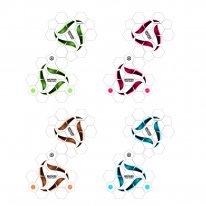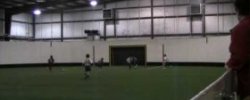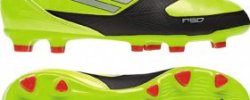The Brazuca's six curvy panels and nubby surface help it to go much more predictably.
PHOTOGRAPH BY DANIEL KARMANN, PICTURE-ALLIANCE/DPA/AP
World Cup football balls was once very little distinct from regular football balls—32 leather panels stitched collectively manually. Although balls utilized in World Cup tournaments happen unique since 2006, whenever Adidas revealed the Teamgeist, manufactured from only 14 panels that had been glued collectively in the place of stitched. The company has been exposing new World Cup balls since: the eight-panel Jabulani baseball this year and for the 2014 games—which start on June 12 in São Paulo, Brazil—the six-panel Brazuca.
Will this change in design really make a difference within the game? That's what Sungchan Hong along with his colleagues within University of Tsukuba wished to discover. Utilizing some soccer balls, a wind tunnel, and a robot, they discovered, relating to today's Scientific Reports, that a ball's building does indeed affect just how it flies through atmosphere.
What is most appropriate in a basketball's movement is drag, a power which makes it dip and curve in unexpected means. The smoother the ball, the greater the drag at higher speeds—and with fewer panels that are glued rather than stitched together, the World Cup balls have been getting increasingly smoother.
Which is the reason why this present year the Brazuca baseball is covered in small nubs—an make an effort to reduce the alleged knuckling impact, that causes the basketball to maneuver unpredictably through air like a knuckleball in baseball.
In the wind tunnel, Hong found, the direction in which the baseball is directed, and thereby the way where panels are focused, changes the drag. This is a problem the 8-panel Jabulani baseball and the 14-panel Teamgeist basketball, all of which journeyed even more unpredictably than a normal football ball, curving pretty much depending on which means it was focused.
Nevertheless brand-new 6-panel Brazuca is apparently a lot more trustworthy, showing little difference between behavior no matter what it really is rotated. This is certainly most likely due to the way the panels regarding the Brazuca are arranged, combined with rough area Adidas included with reduce the drag.
Nonetheless, there's a big difference between a wind tunnel and a field in Brazil, stated Simon Choppin, a specialist at Sheffield Hallam University in Great Britain, who was simply perhaps not mixed up in study. "The wind tunnel can re-create really specific spin problems, "he said, "however for a pass or shot, the spin might-be very different. That is the significant gap between the wind tunnel make sure truth."
No person, Choppin stated, did a wind tunnel simulation of a new player wanting to hook a 40-yard pass around a defender. He included that most plays won't be impacted after all: The drag results Hong along with his group saw in wind tunnel had been under very certain, managed problems, with regards to temperature, moisture, additionally the like—all that evaporate once players step on the field.
But Jay Cooney, an assistant mentor with Sky Blue FC, a group inside nationwide ladies Soccer League, said that even on the area, "there is an enormous difference between balls." He added the quirks are most evident when you look at the first-round games, as players adjust to a brand new ball, "even though announcers typically chalk it to nerves."
Yet Cooney won't trade the weirdness of the World Cup balls for lots more reliability: "That's what i do believe is charming about soccer—it doesn't always have to-be perfect."
juego online















